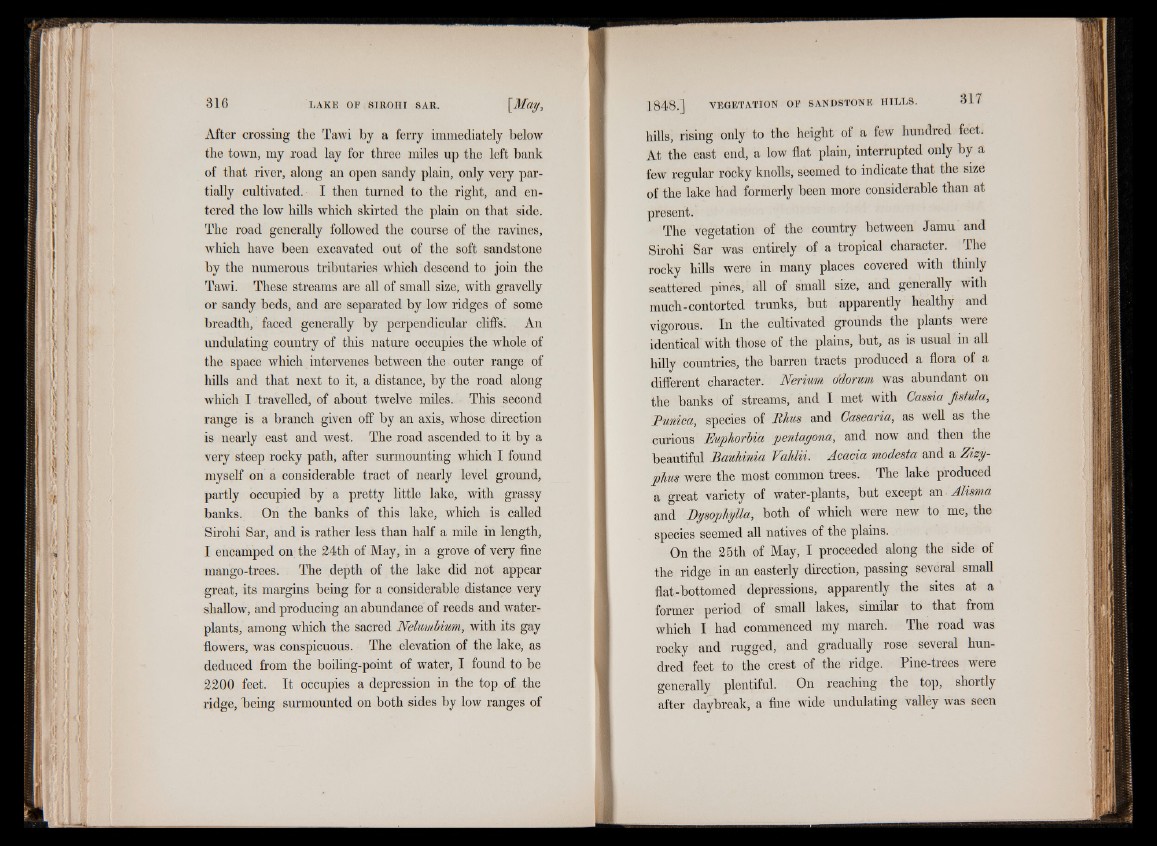
After crossing the Tawi by a ferry immediately below
the town, my road lay for three miles up the left bank
of that river, along an open sandy plain, only very partially
cultivated. I then turned to the right, and entered
the low hills which skirted the plain on that side.
The road generally followed the course of the ravines,
which have been excavated out of the soft sandstone
by the numerous tributaries which descend to join the
Tawi. These streams are all of small size, with gravelly
or sandy beds, and are separated by low ridges of some
breadth, faced generally by perpendicular cliffs. An
undulating country of this nature occupies the whole of
the space which intervenes between the outer range of
hills and that next to it, a distance, by the road along
which I travelled, of about twelve miles. This second
range is a branch given off by an axis, whose, direction
is nearly east and west. The road ascended to it by a
very steep rocky path, after surmounting which I found
myself on a considerable tract of nearly level ground,
partly occupied by a pretty little lake, with grassy
banks. On the banks of this lake, which is called
Sirohi Sar, and is rather less than half a mile in length,
I encamped on the 24th of May, in a grove of very fine
mango-trees. The depth of the lake did not appear
great, its margins being for a considerable distance very
shallow, and producing an abundance of reeds and water-
plants, among which the sacred Nelumbium, with its gay
flowers, was conspicuous. The elevation of the lake, as
deduced from the boiling-point of water, I found to be
2200 feet. It occupies a depression in the top of the
ridge, being surmounted on both sides by low ranges of
hills, rising only to the height of a few hundred feet.
At the east end, a low flat plain, interrupted only by a
few regular rocky knolls, seemed to indicate that the size
of the lake had formerly been more considerable than at
present.
The vegetation of the country between Jamu and
Sirohi Sar was entirely of a tropical character. The
rocky hills were in many places covered with thinly
scattered pines, all of small size, and generally with
m u ch -contorted trunks, but apparently healthy and
vigorous. In the cultivated grounds the plants were
identical with those of the plains, but, as is usual in all
hilly countries, the barren tracts produced a flora of a
different character. Nerium ddorum was abundant on
the banks of streams, and I met with Cassia fistula,
Punica, species of Rhus and Casearia, as well as the
curious Euphorbia pentagona, and now and then the
beautiful Bauhinia Vahlii. Acacia modesta and a Zizy-
phus were the most common trees. The lake produced
a great variety of water-plants, but except an Alisma
and Dysophglla, both of which were new to me, the
species seemed all natives of the plains.
On the 25th of May, I proceeded along the side of
the ridge in an easterly direction, passing several small
flat-bottomed depressions, apparently the sites at a
former period of small lakes, similar to that from
which I had commenced my march. The road was
rocky and rugged, and gradually rose several hundred
feet to the crest of the ridge. Pine-trees were
generally plentiful. On reaching the top, shortly
after daybreak, a fine wide undulating valley was seen